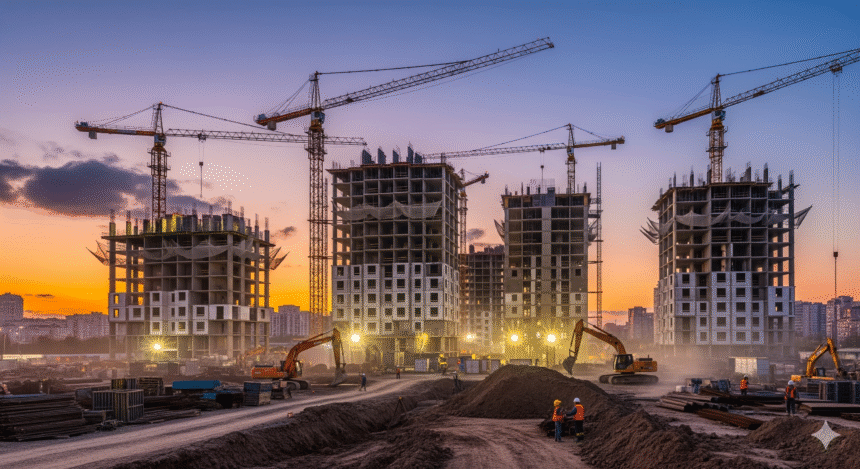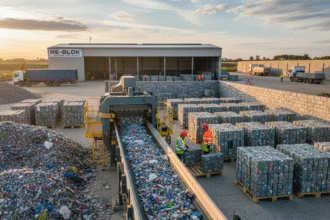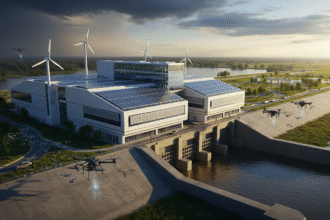Construction has always been one of the pillars of the U.S. economy, providing jobs and shaping communities. But in 2025, the industry is feeling the brakes. After several years of busy hiring and nonstop projects, the pace of work is easing. Builders are facing higher costs, policy changes, and weaker demand in housing, all of which are making companies think twice before taking on new workers.
The cranes are still up, and projects are still moving forward, but the energy of past years isn’t there. To see why, we need to look at the different pressures, from housing to labor shortages, that are slowing the industry down this year.
1. Economic Slowdown Hits Construction
Across the U.S., hiring has slowed sharply, not just in construction, but across key sectors. From May to July 2025, construction jobs shrank from an average gain of 16,000 per month last year to just about 2,000 now. Meanwhile, openings for construction roles dropped significantly: in March, there were 90,000 fewer job openings compared to a year earlier, a 27% drop. Builders aren’t laying people off, but they’re simply not hiring in the numbers they once did.
2. Cost Pressures and Policy Headwinds
Rising material costs are adding to the strain. Steel, copper, and aluminum, suddenly more expensive, in part due to new tariffs and the uncertainty around them, have made many builders pause projects. One industry voice explained how these shifts, from tax changes to trade policy, create worry that can cool project planning and push developers to hit the pause button.
3. Housing Demand Loses Steam
Home construction used to be a growth engine. But now, high mortgage rates, rising home prices, and increasingly cautious buyers have slowed demand. April saw only a modest 3,400 residential construction jobs added amid flat hiring for a full year. Over six months, there was actually an average monthly loss of around 1,500 jobs in home building.
As a result, the unemployment rate for construction workers rose to 5.2%. Housing-related construction now lags behind pre-recession levels. Economists estimate this drag is reducing GDP growth by about 0.2 percentage points in mid-2025.
4. Labor Shortages Worsened by Immigration Crackdown
The construction industry relies heavily on immigrant labour, workers who perform many skilled trades. But 2025 has seen intensified immigration enforcement. In Texas, for instance, ICE conducted raids on construction sites, detaining workers exercising their legal right to work.
Many contractors reported their labour pool was cut in half as workers stayed away for fear of detainment. Experts estimate a national shortfall of 200,000 to 400,000 workers, as smaller firms that rely on undocumented labour find themselves in crisis.
5. Shifting Demand and Project Types
It’s not that everything is slowing. Some big public projects, like infrastructure, schools, recreation, and healthcare facilities, continue to move ahead, helped by federal funding and early planning. Megaprojects, especially in civil engineering and public works, are still going forward. In contrast, sectors like multifamily housing, lodging, and commercial or industrial buildings are lagging or contracting.
6. Builders Holding On, But Not Expanding
Though hiring has slowed, layoffs remain minimal. Many contractors are keeping existing staff in place because they expect conditions to improve down the road. A report in June noted contractors added 4,000 jobs that month, but these gains were modest compared to past years, and market uncertainty was making firms cautious.
A Complex Slowdown, Not a Collapse
In one sense, construction continues to grow in many areas, but at a slower pace. Residential projects are cooling, costs are rising, policy changes loom large, and labour is scarcer, all while demand shifts to public and megaprojects. Immigration enforcement, in particular, has hit smaller firms hard, shrinking the pool of available labour. Builders seem to be in a holding pattern: keeping key workers on in the hope that economic and policy clarity will return.









